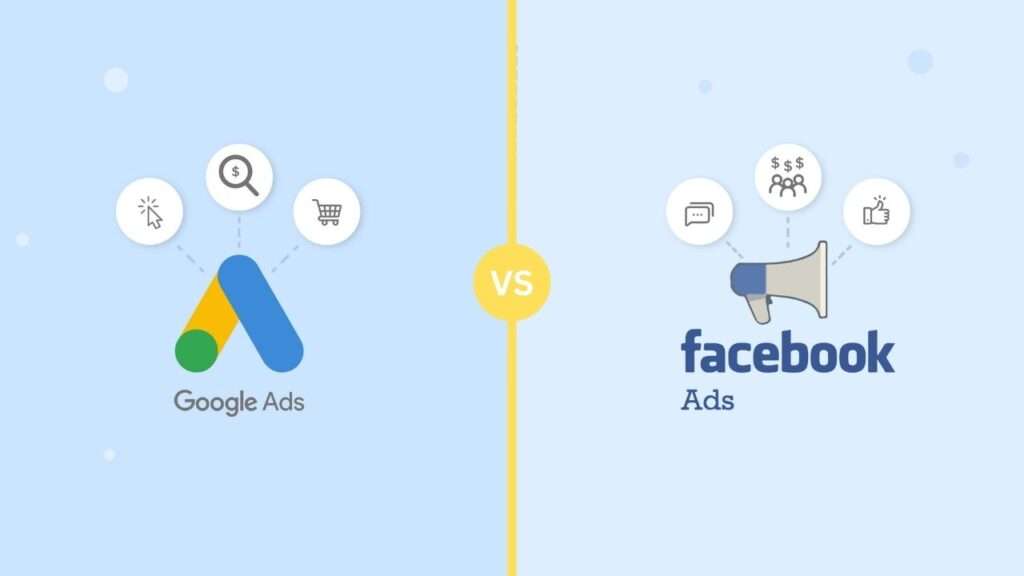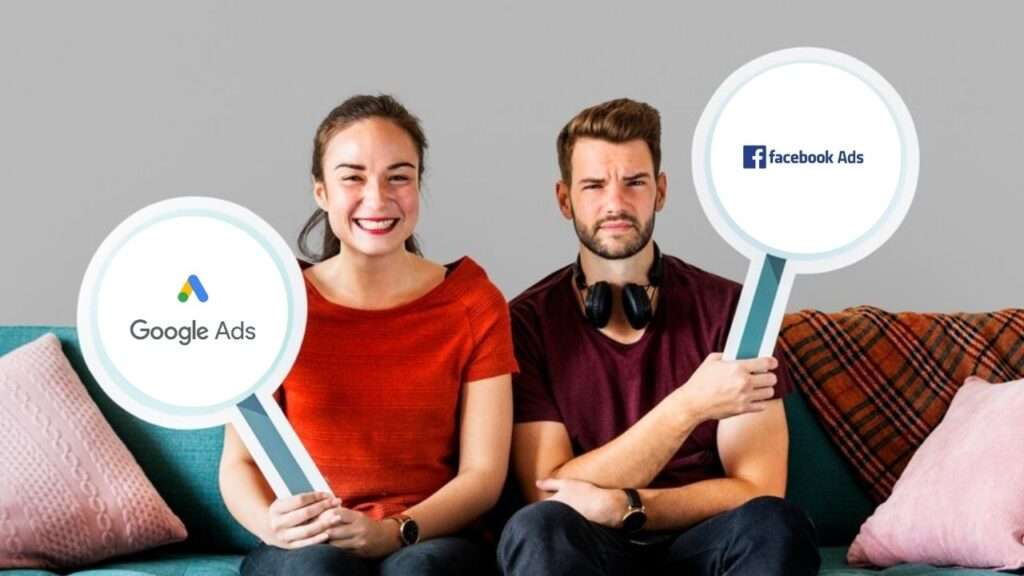
In the evolving digital marketing landscape, two platforms have dominated the paid advertising sphere: Google Ads and Facebook Ads. Both platforms have unique benefits, targeting capabilities, and campaign options, yet they differ significantly in how they reach audiences and the outcomes they drive. For businesses looking to invest in online advertising, understanding the differences, advantages, and drawbacks of each platform is essential for optimizing ad spend and achieving marketing goals.
Below we dive into a detailed comparison of Google Ads vs Facebook Ads, guiding you to determine which is best for your business needs.
Understanding Google Ads and Facebook Ads
Google Ads (formerly AdWords) is an intent-based advertising platform, primarily serving ads to users actively searching for specific information, products, or services. As the leader in search advertising, Google Ads enables businesses to appear at the top of search engine results pages (SERPs), connecting them with potential customers right at the moment of need.
Facebook Ads, on the other hand, is a social media-based advertising platform focused on display advertising. Rather than targeting search intent, Facebook Ads leverages user data, interests, and behaviors, making it highly effective for brand awareness, audience engagement, and customer loyalty on both Facebook and Instagram.
Key Differences Between Google Ads and Facebook Ads

Understanding the primary differences between Google Ads and Facebook Ads is essential for deciding which platform will most effectively achieve your business objectives. Here’s a breakdown:
- Audience Targeting: Google primarily targets users based on search intent, while Facebook leverages detailed user data to reach audiences based on interests and behavior.
- Ad Formats: Google offers search, display, shopping, and YouTube ads, while Facebook provides image, video, carousel, and collection ads.
- Cost Models: Google Ads primarily uses a pay-per-click (PPC) model, while Facebook allows both PPC and cost-per-impression (CPM) bidding options.
- Objective Suitability: Google is best for conversions driven by immediate intent, while Facebook excels at awareness and engagement through social interactions.
When to Use Google Ads
Google Ads is a powerful tool for businesses seeking immediate customer conversions. Here’s why Google Ads might be ideal for you:
- High Purchase Intent: Google Ads connects you with users actively searching for products or services, making it ideal for driving conversions from potential customers who are already considering a purchase.
- Broad Reach Through Search and Display Networks: Google’s extensive search and display networks allow advertisers to reach users across millions of sites and apps.
- Ad Types: Google Ads offers diverse ad types to meet various objectives, including search ads for visibility on SERPs, display ads for brand awareness, shopping ads for e-commerce, and YouTube ads for video marketing.
When to Use Facebook Ads
Facebook Ads, known for its visual and engaging content, is ideal for businesses focused on brand-building and audience engagement. Here are situations where Facebook Ads can outperform Google Ads:
- Detailed Audience Targeting: Facebook’s unparalleled targeting options allow advertisers to reach audiences based on demographics, interests, online behaviors, and even purchase history.
- Visual Storytelling Opportunities: Facebook Ads provides formats like image, video, and carousel ads that are well-suited for visually engaging content, making it an excellent platform for showcasing product benefits and brand stories.
- Retargeting Potential: Facebook’s retargeting capabilities allow advertisers to reconnect with users who have previously visited their website or interacted with their content, increasing conversion likelihood.
Google Ads vs Facebook Ads: Cost Comparison

Costs vary between Google Ads and Facebook Ads, often influenced by competition, audience targeting, and ad quality.
- Google Ads Costs: Google’s PPC model charges advertisers based on user clicks. Costs per click (CPC) can be higher in competitive industries, such as finance or law, where keywords are highly sought after. CPCs on Google can range significantly, from as low as $1 to over $50 in competitive fields.
- Facebook Ads Costs: Facebook generally has lower CPCs, averaging between $0.50 and $3, depending on targeting and audience size. However, Facebook’s cost-per-thousand-impressions (CPM) can also impact overall expenses, especially for brand awareness campaigns aimed at reaching broader audiences.
Strengths and Weaknesses of Google Ads
Strengths
- High Intent-Based Traffic: Google Ads reaches users who are actively searching, resulting in high conversion potential.
- Broad Audience Reach: With over 5.6 billion searches per day, Google Ads offers unmatched reach across industries.
- Diverse Ad Formats: Options for search, display, shopping, and video ads make Google Ads versatile for different objectives.
Weaknesses
- High CPC in Competitive Markets: CPCs for popular keywords can become costly, especially for small businesses with limited budgets.
- Limited Visual Appeal: Traditional search ads on Google rely primarily on text, which may not capture users’ attention as effectively as visual content.
Strengths and Weaknesses of Facebook Ads
Strengths
- Advanced Audience Targeting: Facebook ads can unmatchedly target users based on interests, behaviors, and demographics.
- High Engagement Rates: Facebook’s platform supports user engagement and allows businesses to build brand loyalty over time.
- Cost-Effective for Brand Awareness: Facebook’s lower average CPC and CPM make it ideal for businesses with brand awareness and engagement goals.
Weaknesses
- Lower Purchase Intent: Facebook users often engage with content out of interest rather than intent to buy, which can result in lower conversion rates.
- Limited Reach in Search-Based Marketing: Facebook doesn’t reach audiences actively searching for specific products or services, making it less effective for immediate conversions.
Integrating Google Ads and Facebook Ads in a Unified Strategy

Combining Google Ads and Facebook Ads may provide the best results for businesses seeking to maximize reach and conversions. Here are some approaches to integrating both platforms:
- Awareness with Facebook, Conversions with Google: Use Facebook Ads to build brand awareness and retarget these engaged users with Google search or shopping ads when they actively search for related terms.
- Retargeting Across Platforms: Retarget visitors who came from Google Ads using Facebook retargeting ads, ensuring brand recall and increased chances of conversion.
- Tailored Content for Each Platform: Use Google Ads for keyword-targeted search campaigns and leverage Facebook’s visual ad formats to engage users with high-quality images and videos that showcase brand values and personality.
Choosing Between Google Ads vs Facebook Ads
The choice between Google Ads and Facebook Ads ultimately depends on your target market, budget, and business targets:
- For Businesses Focused on Direct Conversions: Google Ads is the better option, particularly for those targeting users with immediate purchase intent.
- For Businesses Focused on Brand Awareness and Engagement: Facebook Ads are ideal for storytelling, building brand loyalty, and reaching specific demographic groups.
Tips for Maximizing Ad ROI on Google and Facebook
To get the best ROI from Google and Facebook Ads, consider these strategies:
- Optimize Ad Creatives: High-quality images and engaging copy are crucial, especially for Facebook’s visual-based ads.
- Refine Targeting: Regularly assess and adjust targeting parameters on Facebook and Google to reach the most relevant audience segments.
- Use A/B Testing: Run A/B tests on ad copy, images, and calls-to-action (CTAs) to determine the most effective variations.
- Monitor Performance Metrics: Use metrics such as click-through rate (CTR), cost per acquisition (CPA), and return on ad spend (ROAS) to evaluate and optimize campaigns.
Conclusion
In the debate of Google Ads vs Facebook Ads, both platforms offer compelling advantages depending on business needs. Google Ads excels at capturing high-intent traffic, making it ideal for businesses targeting users ready to make a purchase. Conversely, Facebook Ads enable powerful audience targeting, making it ideal for brand-building and engagement efforts. For many businesses, combining both platforms can lead to an effective, well-rounded strategy that captures attention across multiple stages of the buyer journey. Start by defining your business goals, evaluate where your audience spends time online, and tailor your ad campaigns to maximize engagement and conversions.
FAQs
How does Google Ads’ targeting differ from Facebook Ads?
Google Ads targets users based on search intent, reaching them at the moment they’re searching for information. Facebook Ads target users based on detailed demographic, interest, and behavioral data, ideal for engagement and brand awareness.
Are Google Ads or Facebook Ads cheaper?
Facebook Ads generally have lower CPCs and CPMs compared to Google Ads, making them more cost-effective for brand awareness. However, Google Ads may provide higher conversion rates for users with purchase intent.
Which platform is better for e-commerce?
For e-commerce, Google Ads (particularly Shopping ads) are effective at targeting users who are ready to buy. However, Facebook can help drive initial awareness and retargeting.
Can I use both Google Ads and Facebook Ads?
Yes, many businesses benefit from a combined approach, using Facebook for brand awareness and retargeting, and Google Ads for high-intent search-based conversions.
What is the best ad format for Facebook Ads?
Video ads are highly effective on Facebook, followed by carousel ads, which allow showcasing multiple products or features in a single ad.
How do I know which platform to use?
Consider your goals, budget, and audience. Google is ideal for immediate intent and search-based traffic, while Facebook is excellent for social engagement and brand-building.







